Translate this page into:
A novel compound heterozygous variant in the ABCA12 gene associated with mild palmoplantar keratoderma
Corresponding author: Dr. Sheng Wang, Department of Dermatology, West China Hospital, Wuhou District, Guoxue Alley, Chengdu, Sichuan, China. wangsheng1892@126.com
-
Received: ,
Accepted: ,
How to cite this article: Song D, Li J, Zhang F, Luo L, Jiang X, Wang S. A novel compound heterozygous variant in the ABCA12 gene associated with mild palmoplantar keratoderma. Indian J Dermatol Venereol Leprol. doi: 10.25259/IJDVL_438_2024
Dear Editor,
Pathogenic variants in ABCA12 are important causative genetic defects for autosomal recessive congenital ichthyoses (ARCI), including congenital ichthyosiform erythroderma, harlequin ichthyosis and lamellar ichthyosis, often accompanied by palmoplantar keratoderma (PPK).1,2 Occasionally, specific ABCA12 mutations have been linked to milder phenotypes, including erythrokeratodermia variabilis et progressiva and pityriasis rubra pilaris.2,3 This report presents a case of isolated PPK resulting from variants in the ABCA12 gene and reviews such reported mild cases associated with ABCA12 variants.
A 31-year-old healthy woman, employed as a teahouse manager, presented with progressive thickening of the palms and soles since seven years of age, without significant discomfort. On examination, she exhibited mild, thick, yellowish plaques on weight-bearing sites of the palmoplantar areas, notably on the finger flexors and calcaneal regions [Figures 1a, 1b and 1c]. There was no evidence of hyperhidrosis, transgradiens, or a sponge-like appearance after water immersion. No cutaneous involvement suggestive of ichthyosis was noted in other areas of the body, and no abnormalities of nails, hair, or teeth were observed. Family history was noncontributary [Supplementary Figure 1]. Histological examination of the keratotic lesion from the right thumb showed orthohyperkeratosis and acanthosis without acantholysis [Figure 1d].
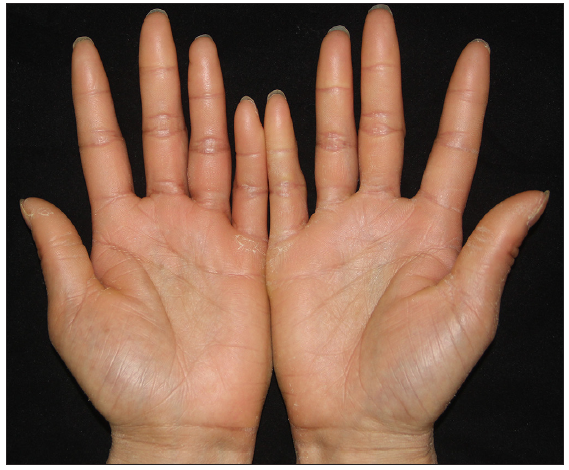
- Mild, thick, yellowish plaques of the palms, notably on the finger flexors.
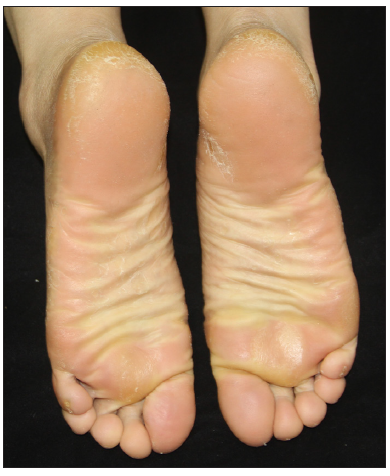
- Thick, yellowish plaques on weight-bearing sites of the plantar areas.
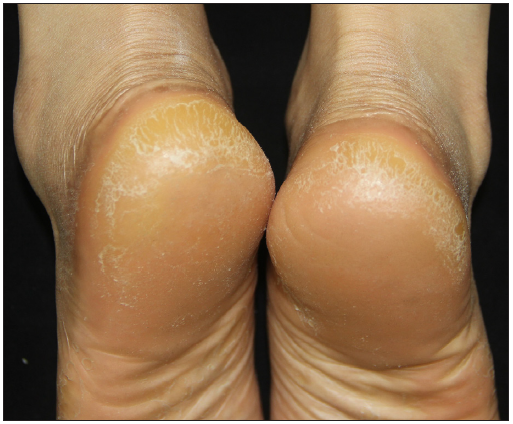
- Thick, yellowish plaques on the calcaneal regions.
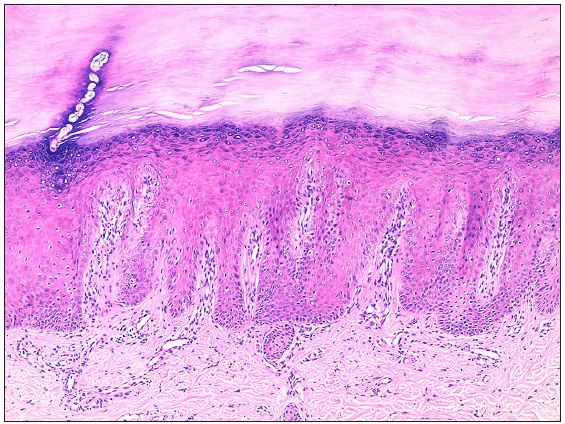
- Orthohyperkeratosis and acanthosis without acantholysis (Haematoxylin-eosin, 100×).
After informed consent and approval from the ethics committee of the institute, peripheral blood samples were taken from the patient and her parents. Whole-exome sequencing identified a novel compound heterozygous variant in the ABCA12 gene in the proband, which was confirmed by Sanger sequencing. This included the duplication variant c.7659_7662dupGAGT (p.Q2555Efs*20) in exon 52, and the missense variant c.7386G>C (p.M2462I) in exon 50, inherited from her mother and father, respectively [Figure 2a]. These observed variants have not been reported from the databases of single nucleotide polymorphisms, ExAC, 1000 genomes, gnomAD, and Exome Variant Server (EVS). Both the variants were predicted to be detrimental using Sorting Intolerant From Tolerant PolyPhen-2, MutationTaster, and Genomic Evolutionary Rate Profiling [Supplementary Figure 2-3]. These variants are classified as uncertain significance according to the American College of Medical Genetics and Genomics (ACMG) guidelines. Moreover, any other disease-causing variants associated with PPK were not detected. Given the genetic defects and clinical features, the diagnosis of isolated PPK associated with ABCA12 variants was established.

- Genetic analysis (sequence chromatogram) showing compound heterozygous variants in the C-terminus of ABCA12, including c.7659_7662dupGAGT (p.Q2555Efs*20) and c.7386G>C (p.M2462I). (A: Adenosine, C: Cytosine, T: Thymine, G: Guanine).
The ABCA12 protein, consisting of 2595 amino acids encoded by 53 exons, plays a crucial role in skin metabolism and keratinisation.1,2 This ATP-binding cassette transporter facilitates the transport of lipid glucosylceramides, crucial for forming the extracellular lamellar membrane.1,2 Disturbances in ABCA12 function can lead to impaired lamellar granules, disrupting intercellular lipid deposition and skin barrier function.1,2 Consequently, hyperkeratosis occurs due to compensatory hyperproliferation of keratinocytes.1
The clinical severity often correlates with the nature of mutations affecting ABCA12 function. For example, potentially fatal harlequin ichthyosis often results from loss-of-function truncating mutations, while biallelic missense mutations typically lead to milder phenotypes like congenital ichthyosiform erythroderma or lamellar ichthyosis.1,2
Recent reports have linked ABCA12 mutations to relatively milder keratinisation disorders2-7 [Table 1]. Several ABCA12 variants have been identified in erythrokeratodermia variabilis, an otherwise dominant disorder resulting from connexin gene defects.2,3 Terrinoni et al. also identified a compound heterozygous mutation in ABCA12 (exon 30 and exon 31) in a family displaying an variabilis et progressiva phenotype.4 Their evaluation of glucosyl-ceramides in the upper epidermal layers suggested a partial depletion of ABCA12 function in the mild phenotype, characterised by reduced and patchy hydroxy ceramide deposition.4 ABCA12 variants also cause a blaschkoid form of congenital ichthyosiform erythroderma due to recessive mosaicism.5 Additionally, cases resembling pityriasis rubra pilaris have been described in association with ABCA12 variants.6 These mild cases often involve unique missense changes in ABCA12, not leading to complete loss of function.6
| Clinical phenotype | Genetic basis | Reference/PMID |
|---|---|---|
| EKV or EKVP |
Compound heterozygous: p.N678Rfs*10; c.2866-8T>A Compound heterozygous: p.D844G;p.P1938S Compound heterozygous: p.Y1929*; p.E2284D |
Sun Q, et al. 2 PMID: 34851365 |
| Compound heterozygous: H1471R; T1534M |
Terrinoni A, et al.4 PMID: 37762265 |
|
| Compound heterozygous: p.P2416L; p.Y1218C |
Liu Y, et al.3 PMID: 38085035 |
|
| PRP |
Homozygous: p.T1534M Homozygous: p.R2426W |
Takeichi T, et al.6 PMID: 37752865 |
| Nevoid form of CIE |
Recessive mosaicism: p.l1257Nfs*4; p.E1227K |
van Leersum FS, et al.5 PMID: 31206590 |
| Mild CIE with periodic exacerbation | Compound heterozygous: p.N2184I; p.I2307Rfs*14 |
Wada Y, et al.7 PMID: 28771802 |
| Isolated PPK | Compound heterozygous: p.Q2555Efs*20; p.M2462I | Our case |
EKV, erythrokeratodermia variabilis; EKVP, erythrokeratodermia variabilis et progressive; PRP, pityriasis rubra pilaris; PPK, palmoplantar keratoderma; CIE, congenital ichthyosiform erythroderma.
In our case, isolated PPK without generalised ichthyosis was noted. The identified causal mutations, located in exon 50 and 52, might cause a potential mild loss of protein function in the C-terminus of ABCA12 [Figure 2b], offering a plausible explanation for the observed mild phenotypes. Given that lesions are localised in weight-bearing and friction areas, environmental factors like pressure might contribute to hyperkeratotic lesions in individuals with a genetic background of hypomorphic ABCA12 variants. However, further functional studies are necessary to validate this hypothesis.
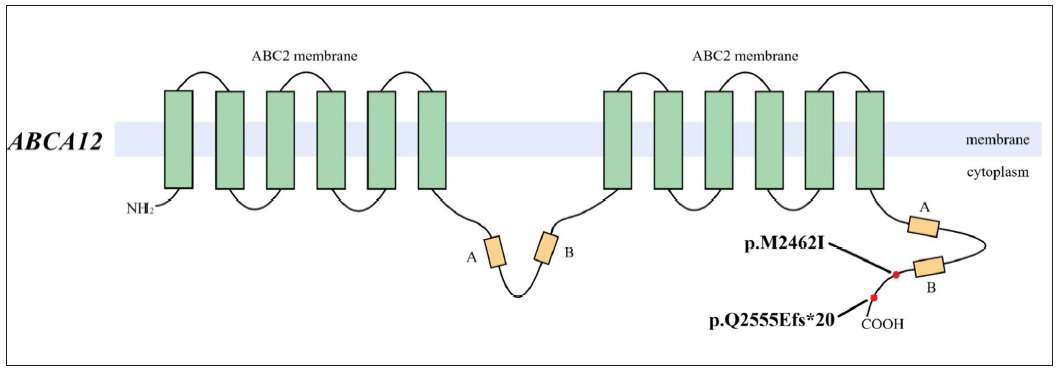
- Schematic representation of the ABCA12 structure showing the identified variants located in the C-terminus. (COOH: carboxylic acid).
In conclusion, we identified a novel compound heterozygous variant in the ABCA12 gene in a patient presenting with a mild form of isolated PPK. Our study expands the phenotypic spectrum associated with ABCA12 variants and underscores the genetic heterogeneity of isolated PPK. Further research is crucial for elucidating precise genotype–phenotype correlations for ABCA12 mutations, particularly in cases with mild phenotypes.
Ethical approval statement
The research/study was approved by the Institutional Review Board at Ethics Committee Biomedical Research, West China Hospital of Sichuan University, number IRB No. 202304705, dated 2023.12.05.
Declaration patient consent
The authors certify that they have obtained all appropriate patient consent.
Financial support and sponsorship
Nil.
Conflicts of interest
There are no conflicts of interest.
Use of artificial intelligence (AI)-assisted technology for manuscript preparation
The authors confirm that there was no use of artificial intelligence (AI)-assisted technology for assisting in the writing or editing of the manuscript and no images were manipulated using AI.
References
- Genotype-phenotype correlation in a large English cohort of patients with autosomal recessive ichthyosis. Br J Dermatol. 2020;182:729-37.
- [CrossRef] [PubMed] [Google Scholar]
- The genomic and phenotypic landscape of ichthyosis: an analysis of 1000 kindreds. JAMA Dermatol. 2022;158:16-25.
- [CrossRef] [PubMed] [PubMed Central] [Google Scholar]
- Novel variants in ABCA12 cause erythrokeratodermia variabilis. Br J Dermatol. 2024;190:454.
- [CrossRef] [PubMed] [Google Scholar]
- Partial loss of function ABCA12 mutations generate reduced deposition of glucosyl-ceramide, leading to patchy ichthyosis and erythrodermia resembling erythrokeratodermia variabilis et progressiva (EKVP) Int J Mol Sci. 2023;24:13962.
- [CrossRef] [PubMed] [PubMed Central] [Google Scholar]
- Recessive mosaicism in ABCA12 causes blaschkoid congenital ichthyosiform erythroderma. Br J Dermatol. 2020;182:208-11.
- [CrossRef] [PubMed] [Google Scholar]
- Patients with keratinization disorders due to ABCA12 variants showing pityriasis rubra pilaris phenotypes. J Dermatol. 2024;51:101-5.
- [CrossRef] [PubMed] [Google Scholar]
- Mild case of congenital ichthyosiform erythroderma with periodic exacerbation: Novel mutations in ABCA12 and upregulation of calprotectin in the epidermis. J Dermatol. 2017;44:e282-e283.
- [CrossRef] [PubMed] [Google Scholar]





